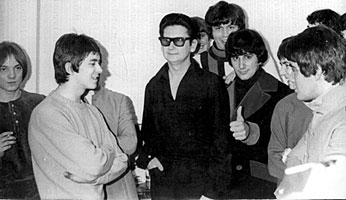Cassady's son doesn't miss a Beat in preserving movement's history
Friday, October 29, 2004
I was on the road with Miss Thing and Peaches explaining the whole second half of the 20th century.
"In 1942 there was World War II, which, even though we won, still devastated everyone in America. It completely unsettled people's sense of security. So from 1945 to 1955, there were 10 years of national devotion to normality and conformity. Post-war folks sought the white picket fence, Beaver Cleaver American dream," I told them.
"Then in 1955 came the writers, poets and painters of the Beat Generation. They changed everything."
We were driving to visit the Traveling Beat Museum and its performer/promoter John Allen Cassady, the son of Neal Cassady. He inspired Jack Kerouac's classic novel "On the Road" and a decade later drove the bus for Ken Kesey's Merry Pranksters.
Talk about countercultural credibility.
I told the kids we were meeting Beat royalty. Even his name was loaded. John Allen was named for Jack Kerouac and Allen Ginsberg, who, along with Neal Cassady, were the troika of the Beat Generation. John Allen Cassady met us with his partners, Jerry Cimino and Garland Thompson, at the Mongolian Barbecue on Coventry Road in Cleveland Heights. The trio had given a performance the night before at the B-Side under the Grog Shop. The event was sponsored by Suzanne DeGaetano of Mac's Backs Paperbacks.
Cimino is the Beat history scholar, Thompson does dramatic readings of classic Beat works, and Cassady plays guitar and answers questions about what it was like growing up with the man some called "the fastest man alive." Neal Cassady lived fast, talked fast, drove fast and loved fast.
"My mom said when my dad named me, it was originally going to be Jack Cassady. But he changed it to John just before signing the birth certificate because he was worried I'd get the nickname Jackass-ady," he said.
John Allen Cassady had been laid off for a year from his tech-support job in Silicon Valley in 2003 when Cimino, who was the owner and curator of the Beat Museum in Monterrey, Calif., contacted him about a traveling Beat Museum. Cimino knew Thompson as an actor and event promoter and thought he would be perfect in helping them spread the Beat gospel.
With a 34-foot silver Airstream RV and a trailer full of Beat books, tapes, T-shirts, posters, etc., they've crisscrossed the country putting on events and seminars at high schools, colleges and bars. They adapt the presentation to suit the crowd. For example, the "dirty parts" of Ginsberg's famous poem "Howl" are edited out of the high school gig.
"One thing I try to get across is that I remember my dad as a father to me and my sisters and a husband to my mom," Cassady said. "I had an idyllic childhood. He worked for 10 years as a brakeman for the railroad. He died at 42, but he lived 12 lifetimes in one. It was like he was everywhere at the same time."
In "Holy Goof," William Plummer's biography of Neal Cassady, the man is described alternatively as a "criminal, saint, lunatic, genius and muse." Jerry Garcia called him "a tool of the cosmos." Kesey called him "irrevocably beyond category." Cassady the son is interested in parsing the man and the myth, all the Beat men and their myths.
"This was not a planned movement' with these guys," Cassady said. "They were not out to change the world with their beliefs. They were simply free thinkers, ahead of their time, who were deeply committed to art. To music, writing and painting. And to each other."
If Kerouac, Neal Cassady and Ginsberg were the holy trinity of the Beat Generation, John Allen Cassady, Cimino and Thompson consider themselves the Larry, Curly and Moe of the next generation. Their bus ran out of gas coming up Cedar Hill on the way to the B-Side performance. DeGaetano rescued them. But then Neal Cassady was always pushing the envelope when he drove.
"Once we were broken down on the highway, and we couldn't get the bus to go," said Cimino, who also runs the www.kerouac.com Web site.
"John tells us that his dad's advice for a stalling vehicle was always to stand on the accelerator. He would shout STAND ON IT!' at the top of his lungs. I did, and the engine boomed and turned over just like that. We were channeling Neal."
I had to ask Cassady what he remembered about Kerouac, my writing hero.
"When he visited he always slept in a sleeping bag in the back yard under a tree," Cassady said. "In the morning, we'd run out and jump on him. My older sister Cathy obviously spent more time with him than I did. I visited her recently in California. She has a frame around the license plate of her car that reads Jack Liked Me Best.' "













 with
with



